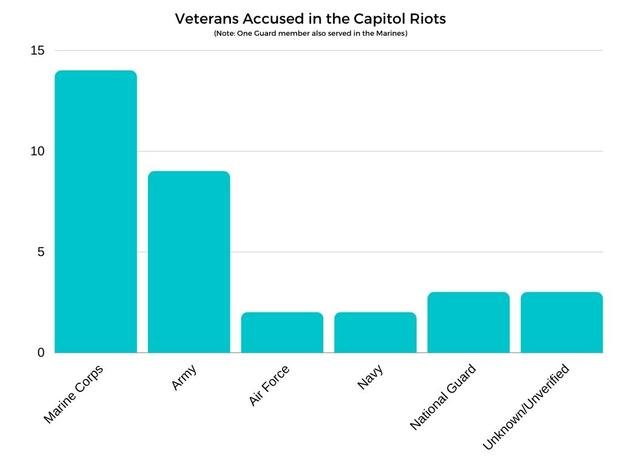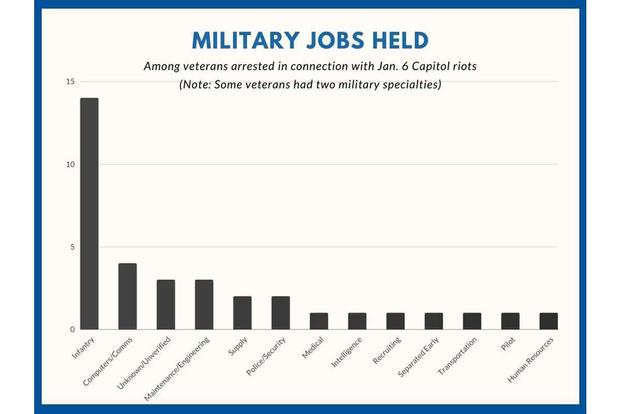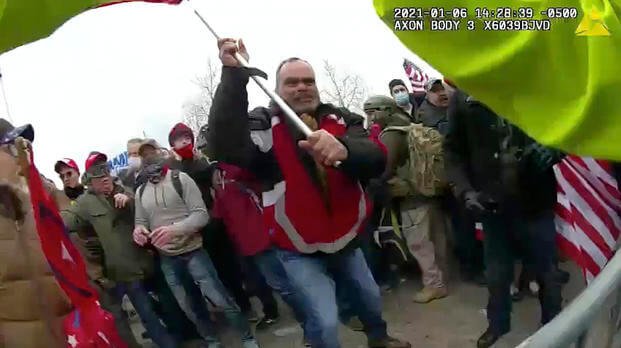Thomas Webster was carrying a large pole with the iconic scarlet and gold U.S. Marine Corps flag on the end when his image was caught on the body camera of a police officer dispatched to the U.S. Capitol on Jan. 6.
Webster, a retired New York Police Department officer who served as a Marine infantry rifleman, was allegedly filmed berating the cop while holding the flag bearing the eagle, globe and anchor.
He's accused of calling the cop a "piece of sh--" and a communist before pushing a gate into the police officer's body. He then allegedly lifted the flagpole above his head and forcefully struck the metal barricade in front of the Washington, D.C., Metropolitan Police Department officer.
"Webster then attempts to attack [the officer] by lunging toward him with the metal flagpole," a federal criminal complaint filed against the 54-year-old states. It accuses Webster of striking the police officer with the pole several times before the cop wrestled it away.
As the officer retreated further behind the metal barricade, Webster broke past it, the complaint adds, and the Marine vet charged the police officer "with clenched fists."
"Webster ultimately lunges at [the police officer] and tackles him to the ground," the complaint states. "Webster's assault ... on the ground lasts approximately ten seconds."
When Webster surrendered to law enforcement this week, he joined a list of nearly three dozen people with military ties accused of participating in the violent January siege of the U.S. Capitol -- one of whom was shot dead inside the building.
Like Webster, many veterans accused of participating in the mob -- which has led to federal charges against more than 250 people, congressional hearings, and the second impeachment trial of President Donald Trump -- have ties to the Marine Corps. That's despite the service being the Defense Department's smallest branch, with the exception of the Space Force, which was created in 2019.
More than 40% of the 32 veterans arrested after the Capitol riot are affiliated with the Marines. Thirteen of them served in the Marine Corps, according to service records, and one shipped off to boot camp but was separated mid-training.

The Marine Corps did not respond to a request for comment about the number of suspects having ties to that service.
Jonathan Wong, a former Marine Corps infantry officer who now works as a policy researcher, said he believes there are cultural reasons for the trends seen in the Capitol arrests.
"Even before people started confirming there was a high proportion of veterans [in the Jan. 6 riots], I kind of had an inkling," he said.
As he watched the scene unfold in real time on the news, Wong said he began to mumble the military's oath of enlistment under his breath -- an oath that he said likely meant something entirely different to the veteran rioters and members of militia groups than it did to him.
"I think there are some things that are particular about the Marine Corps, in my experience, that may lead them to that," he said. "At its best, it's about serving a cause that's bigger than yourself and drawing from this deep well of history, and drawing from heroes in the past and heroes in the future. ... I can see how that search for meaning for many Marines afterward, particularly for infantrymen who might have different employment prospects, can lead them to identifying with a cause greater than themselves. Wanting to be a part of something, to serve some kind of struggle, it's baked into the Marine Corps."
The Army, the military's largest branch at nearly three times the size of the Marine Corps, has the next-biggest representation among the veterans arrested, with nine soldiers accused of participating. The Air Force and Navy each had two, and the National Guard three. (One of the National Guard members was previously a Marine.)
Service affiliations for three people who have been arrested were not immediately available, but court documents and local media reports claim they're veterans. Three soldiers -- two in the Army Reserve and one in the Virginia National Guard -- were still in uniform at the time of their arrests.
Veterans made up about 7% of the U.S. population in 2018, according to Census Bureau data. Of the 268 arrests made in connection to the Capitol breach, veterans so far represent about 13% of the total -- nearly twice their overall population across the country.
The Justice Department is still identifying and charging suspects daily, so it remains to be seen whether what appears to be a high rate of alleged veteran involvement in the riot holds steady. So far, the DOJ has focused on charging those who appeared to be leading the mob or were seen committing particularly visible acts during the riot, said Beth Bailey, director of the Center for Military, War and Society Studies at the University of Kansas.
Those with military ties might have put themselves at the front of the assault, she said, because of their tactical training or leadership experience. That would make them more visible during the investigation.
"We don't know yet whether military veterans are disproportionately part of this act of insurrection, or whether they were 'only' disproportionately represented in its most aggressive actions," said Bailey, a former West Point and Army War College fellow.
Of the veterans accused of participating in the mob, a dozen deployed to Iraq or Afghanistan. Half of those veterans -- including Ashli Babbitt, the former airman shot to death by a police officer in the Capitol -- deployed multiple times.
Two of the former soldiers who've been arrested, Joseph Randall Biggs and Joshua Lollar, have Purple Hearts. Biggs was a cannon crewmember who deployed to Iraq and Afghanistan. Lollar was an infantryman who deployed to Iraq.
Nearly half of the veterans accused of participating in the mob served in infantry or artillery fields. Federal prosecutors claim some have ties to anti-government groups, such as the Oath Keepers.

Jessica Watkins, who served in the Army infantry and is an alleged member of the Oath Keepers, is accused of holding a training course before the Capitol riot.
Bailey said the high rate of former infantry personnel allegedly being involved could be because some extremist groups actively recruit veterans -- particularly those who trained in ground combat jobs. Top military leaders are weighing whether troops transitioning out of the military need to be warned about the groups that could try to recruit them, Pentagon spokesman John Kirby said this month.
The number of veterans believed to have been involved in the January riot "do demand that we ask why military veterans were acting in this fashion," Bailey said.
"Do appeals to patriotism, however warped in fact, resonate more powerfully with [some of] those who have served?" she asked.
Wong, the former infantry officer, noted that the powerful sense of bonding that emerges from the stressors and close-quarters nature of the infantry in particular can prove difficult for veterans after their time in the military is over. For the Marine Corps, the prominent message "once a Marine, always a Marine" may also suffer from lack of context when it comes to re-entering civilian life, he said.
"I feel like there's an underlying narrative in play there, particularly for the Marine Corps, which leverages narratives to get people to think in a certain way," he said. " ... I wonder if there's a way for the Marine Corps to craft a more vivid narrative about what it means to be a Marine after you've hung [the uniform] up."
-- Hope Hodge Seck can be reached at hope.seck@military.com. Follow her on Twitter @hopeseck.
Related: Veterans Used Their Military Training to Plot Violence in Capitol Riot, Feds Say














